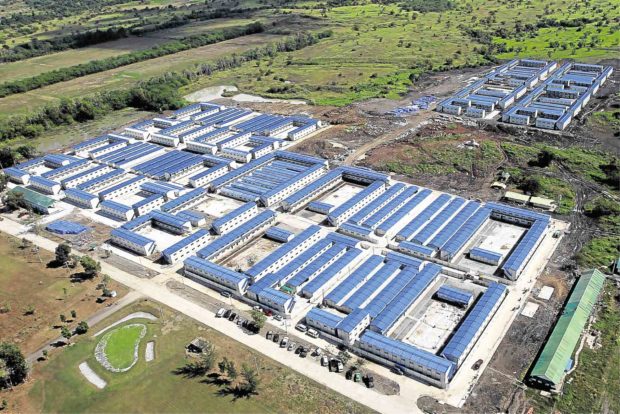
SPRAWLING The government’s P1.4-billion drug rehabilitation center is a huge complex at Fort Magsaysay in Laur, Nueva Ecija province. —MALACAÑANG PHOTO
The word “mega” suggests enormous size and purpose, but the government’s Mega Drug Abuse Treatment and Rehabilitation Center (MDATRC) seems to be an exception.
The facility, which represents President Duterte’s carrot and stick approach to drug abuse, has few takers despite its 10,000-bed capacity.
Although the administration’s campaign against illegal drugs has yielded over a million surrenderers, according to official sources, not many local governments have been sending patients to the Nueva Ecija-based facility.
As of June 16, the MDATRC has been helping 315 male patients, according to Dr. Nelson Dancel, chief of the facility. The treatment center has yet to accept women.
SECURE Army and police personnel protect the complex. —JOAN BONDOC
“We need the support of local governments so we can help more residents,” Dancel said, adding that he does not know why local governments have not tapped the MDATRC to help drug dependents among their constituents.
On Nov. 30, 2016, President Duterte opened the facility located inside Fort Magsaysay, the Philippine Army’s military reservation in Laur, Nueva Ecija. Run by the Department of Health (DOH), the MDATRC was built through a P1.4-billion donation from a Chinese real estate tycoon, Huang Rulan.
The MDATRC is protected by personnel from the Philippine Army, the Philippine National Police and the Bureau of Jail Management and Penology.
Escape attempts
Security was beefed up in February after three resident-patients tried to escape. Two of them ran toward the mountainous and grassy area at the back of the center. A third tried to blend in with a religious parade by helping push a carosa, but was turned over to the police by the priest.
In March, some patients from Batangas province held a noise barrage calling for their release, but they were pacified and had since been cooperative.
Residents inside the facility are assisted by 165 doctors, nurses, psychologists, dentists, social workers and house parents. They get free food, lodging and some amenities like toiletries. Family visits are allowed when residents enter the third phase of their rehabilitation.
The center received a P36-million budget to cover staff salaries, the subsistence of its residents from January to June, and the maintenance of its facilities, said Dr. Leonita Gorgolon, assistant health secretary and director in Central Luzon.
SPARTAN A typical dorm in the rehab center —JOAN BONDOC
Eighty-seven of the center’s patients hail from Nueva Ecija. Sixty one are from Valenzuela City, 48 from Metro Manila, 43 from Pampanga, 41 from Batangas, 10 each from Bulacan and Rizal, four from Cavite, three from Tarlac, two each from Pangasinan and Aurora, and one each from Lucena City, Ilocos Sur, Isabela and Sorsogon.
Dancel said patients classified as having moderate to severe addiction had started to come in during the last few weeks. The latest, four drug dependents from Valenzuela City, were admitted on June 15.
Court orders
Residents—drug dependents whom DOH-accredited doctors recommended for rehab—were asked to sign consent forms and obtain court orders before being committed to the center for a period of six months to a year.
Dancel said 50 patients were undergoing final evaluation for graduation in August.
“[Once they graduate] they (are expected) to live normal lives in their communities. But they will be required to periodically report to the center for the next 18 months,” he added.
Based on the residents’ profiles, Dancel said the drug dependents were seriously addicted to popular street drug “shabu” (methamphetamine hydrochloride), a combination of shabu and marijuana, a mix of shabu, alcohol and nicotine, prescription painkillers, cocaine, and hashish.
Most of them came from poor and middle-class families, although a few were scions of rich families and public officials.
On June 6, the Supreme Court ordered all courts to remand to MDATRC “drug users and pushers who are ordered for treatment and rehabilitation by the courts.”
But Dancel said the MDATRC does not accept people who had been convicted of drug pushing. “Hindi tugma (It’s not consistent). This is a medical facility, not a jail,” he said. —Tonette Orejas and Armand Galang